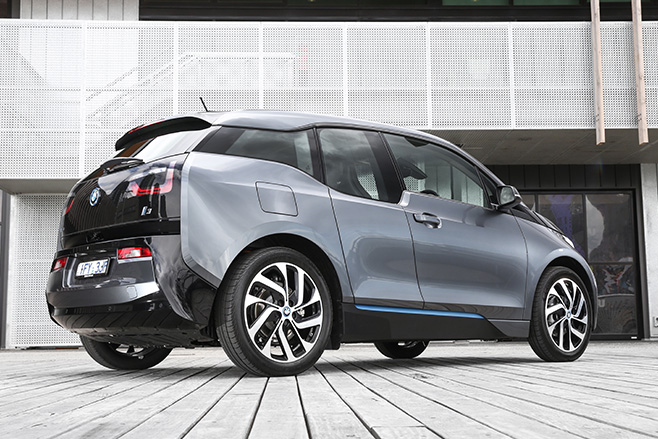
1. The new 94Ah battery is the same physical size as the old 60Ah one. BMW’s eggheads have squeezed more electrolyte into the existing cells, and along with software tweaks to minimise power losses, real-world range between charges has increased from around 130km to around 200km.
2. BMW will sell the $63,990 60Ah version of the BMW i3 alongside the $2000 more expensive 94Ah version. It will also sell the $69,900 60Ah i3 REx – fitted with a two-cylinder petrol-powered generator – alongside the $2000 more expensive 94Ah version.
3. That extra $2000 also buys you a fast DC charger that can top up the i3’s battery in about 40 minutes. However, there is only one of these DC fast chargers in Sydney, and two in Melbourne. Western Australia will soon have a dozen of them allowing electric vehicle owners to drive from Perth to Margaret River.

4. If you buy a 60Ah i3, that fast DC charger will cost you an extra $769.
5. BMW says adding the DC fast charger to the 94Ah i3 future-proofs it for the day that more of the rapid chargers come on board.
6. BMW says the average daily commute is around 40km. If you buy the less energy-dense i3 battery you’re going to be charging it about every three days. Buy the bigger one and you only need to recharge it about every fifth day.
7. Because it has more electrolyte in it, the i3 94Ah’s battery weighs 50kg more. It’s the equivalent of carrying an extra passenger compared with the 60Ah version.
8. Germans who own the 60Ah version of the i3 can upgrade their battery to the new 94Ah one to get more range. BMW Australia says it is looking at how it can do the same thing here.

9. The i3’s dash is pretty strange to look at. Stringy and mottled grey, you’d swear it was a felt-like surface. Touch it, though, and it’s hard plastic.
10. The i3’s leather seats are stained dark using an extract of olive oil leaves. Cloth seat covers are 40 percent wool.
11. In ordinary city driving, the i3’s regenerative braking converts the energy usually lost during braking into electricity to top up the battery. It kicks in quite severely, so lifting off the accelerator is like putting a foot lightly on the brakes. In slow-moving traffic you don’t even need to touch the brake pedal.
13. Aussie car buyers appear to remain anxious about “range anxiety”; the name given to the fear that the battery will run out of juice short of the destination. It expects sales to skew 70 percent to the range-extended car, and 30 percent to the battery-only version.
14. The generator on the range extender is powered by a two-cylinder 660cc petrol engine. It produces 28kW, or about the same as a small motorcycle, and weighs 75kg.
15. Each tank of fuel on the i3 REx lasts about 120km.



